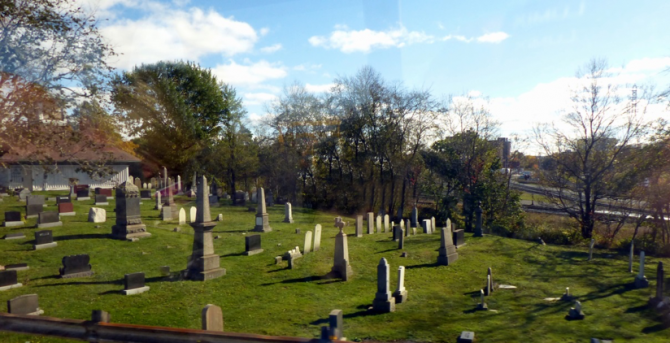Written by Kristine, Staff Member, Halifax Central Library
"I like the cemeteries downtown
That’s where I take my sinking thoughts to drown
And when it rains on the gravestones, the moss is all around
And it covers marks on me I’ve never found"
Old Man Luedecke’s haunting song, Cemeteries Downtown, says it all for me: I truly enjoy hanging out in cemeteries. I inherited this interest through a family connection—my grandfather sold gravestones, many of which stand in the large and beautifully landscaped Mt. Pleasant Cemetery, opens a new window near my family home in Toronto.
My Dad used to take me to Mount Pleasant for walks and bike rides, always pointing out the stones that had been sold from our family business. Along with the thousands of graves, Mt. Pleasant is home to many magnificent and unusual trees. We always found some kind of beautiful flower in bloom, and occasionally we might even see a rabbit or a fox. Sometimes it felt a little bit spooky, but I always found the cemetery a fascinating place.
The Old Burying Ground
As a person who likes cemeteries, it makes sense that I ended up in Halifax—a city that has retained at least 4 historic burial places in its downtown core.
When I hear the song Cemeteries Downtown, I always imagine the singer lurking around St. Paul’s Cemetery, better known as the the Old Burying Ground, opens a new window. St. Paul’s is just steps away from Halifax Central Library, at the corner of Spring Garden Road. and Barrington Street.
Founded in 1749, the year Halifax became a permanent settlement, the cemetery operated for less than a hundred years. Its last burial took place in January of 1845. Many of the monuments are now so weathered, they can hardly be read—but thankfully there are books like Daniel Shimabuku’s 1981 volume of St. Paul's Cemetery. This book, though older, documents an archaeological study of the old burying ground, and includes transcribed inscriptions, maps, and sketches of the typical styles of graves found in the cemetery.
St. Paul's Cemetery, Halifax, Nova Scotia, Canada
Maps of disaster
Visiting cemeteries can teach you a lot about the history behind the place whose dead they house.
The older cemeteries of Halifax and Dartmouth contain many graves with the same date of death: December 6, 1917—the Halifax Explosion. Gone But Not Forgotten: Victims of the Halifax Explosion in Catholic Cemeteries is one of the most recent cemetery-related titles in our collection. It was commissioned in honour of the 100th anniversary of the explosion, and provides a short background on the events of the disaster as well as short biographies of explosion victims buried in each of the Catholic Cemeteries of Halifax, opens a new window.
Gone but Not Forgotten: Victims of the Halifax Explosion in Catholic Cemeteries
One of the most famous of these victims is Vincent Coleman, opens a new window, the heroic railway dispatcher who saved many lives that day.
Many visitors to Halifax also seek out Fairview Lawn Cemetery, the resting place of many of those whose bodies were recovered from the Titanic disaster in 1912, opens a new window.
I’ve also spent a little time walking around Holy Cross cemetery on South Street, where you can see the graves of entire families who died of the 1918 influenza epidemic. It’s very sad—but I’m thankful we live in a time of better medical care.
A hidden gem
One of my personal favourite Halifax haunts is the churchyard at the Little Dutch Church, opens a new window on Brunswick St.
Set aside as a burial ground for the early German-speaking protestant community of Halifax in 1752, the tiny church and graveyard remain nestled, and almost hidden, below the looming apartment buildings of Ocean Towers. The site has been an important source of archaeological information, documented in several books in our collection.
Doing your family tree? Visit a cemetery.
Cemeteries have long been a major resource for those researching their family tree, because they provide names, dates (and sometimes places) of birth and death, and often information on marriage links.
The Local History Room at Halifax Central Library has a wide range of resources on the cemeteries of Nova Scotia. Many of these are locally published books, not available elsewhere. They will help you discover interesting family information about the picturesque little churchyards you can see driving all over the province. An example might be Our Ancestors, They Rest Here by Linda Gray-Leblanc. This book provides photos of each headstone in several small cemeteries in the Herring Cove-Sambro area. With an alphabetical index of names, it’s a resource that can save a researcher a great deal of time.
For those whose families rest further afield, don’t despair—there are many wonderful online resources to find headstone information. One, often used by Ancestry.com, is the Find-a-Grave index. It’s a database of thousands of photographs and inscriptions from gravestones around the world. The only mandatory information to search is a surname, although you can also narrow down by first name, location, and dates of birth and death.
The same line viewed from different sides
"Life and death are one thread, the same line viewed from different sides." - Lao Tzu
Cemeteries are as much about life as they are about death. They are a link to our past, quiet places where garden landscapes thrive, and they provide a visible reminder to cherish life while we have it.
Do you have a favourite cemetery you’d like to share? Comment below to add your thoughts.
(1) [GFDL (http://www.gnu.org/copyleft/fdl.html, opens a new window) or CC-BY-SA-3.0 (http://creativecommons.org/licenses/by-sa/3.0/, opens a new window)], via Wikimedia Commons.
(2) [CC BY 3.0 (https://creativecommons.org/licenses/by/3.0, opens a new window)], via Wikimedia Commons/em>
(3) (https://www.flickr.com/photos/archer10/2284450048/, opens a new window) [CC BY-SA 2.0 (https://creativecommons.org/licenses/by-sa/2.0, opens a new window)], via Wikimedia Commons





Add a comment to: Cemeteries Downtown: Historical Halifax